Sebastian Möller
Multilingual Datasets for Custom Input Extraction and Explanation Requests Parsing in Conversational XAI Systems
Aug 20, 2025Abstract:Conversational explainable artificial intelligence (ConvXAI) systems based on large language models (LLMs) have garnered considerable attention for their ability to enhance user comprehension through dialogue-based explanations. Current ConvXAI systems often are based on intent recognition to accurately identify the user's desired intention and map it to an explainability method. While such methods offer great precision and reliability in discerning users' underlying intentions for English, a significant challenge in the scarcity of training data persists, which impedes multilingual generalization. Besides, the support for free-form custom inputs, which are user-defined data distinct from pre-configured dataset instances, remains largely limited. To bridge these gaps, we first introduce MultiCoXQL, a multilingual extension of the CoXQL dataset spanning five typologically diverse languages, including one low-resource language. Subsequently, we propose a new parsing approach aimed at enhancing multilingual parsing performance, and evaluate three LLMs on MultiCoXQL using various parsing strategies. Furthermore, we present Compass, a new multilingual dataset designed for custom input extraction in ConvXAI systems, encompassing 11 intents across the same five languages as MultiCoXQL. We conduct monolingual, cross-lingual, and multilingual evaluations on Compass, employing three LLMs of varying sizes alongside BERT-type models.
The TUB Sign Language Corpus Collection
Aug 07, 2025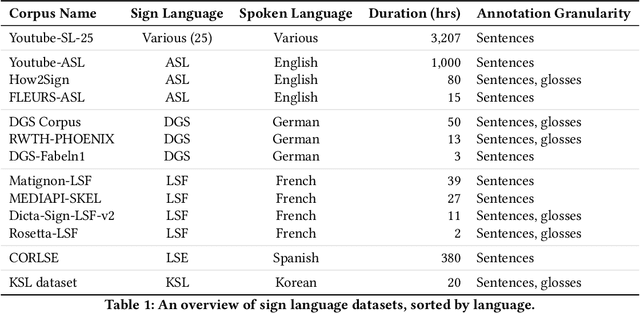
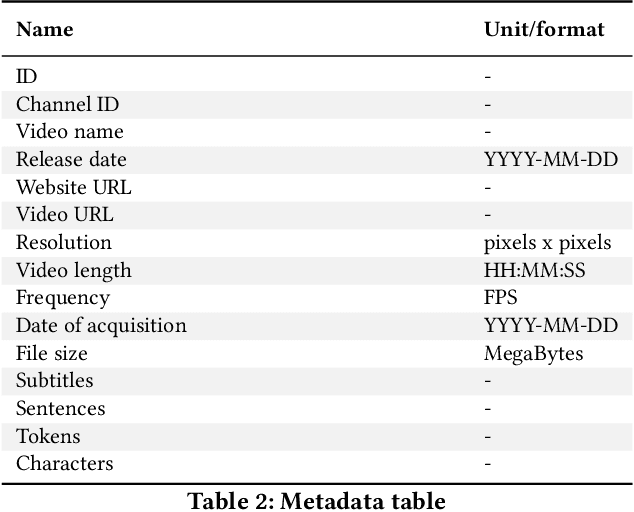
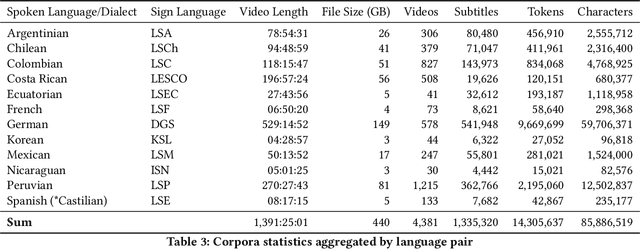
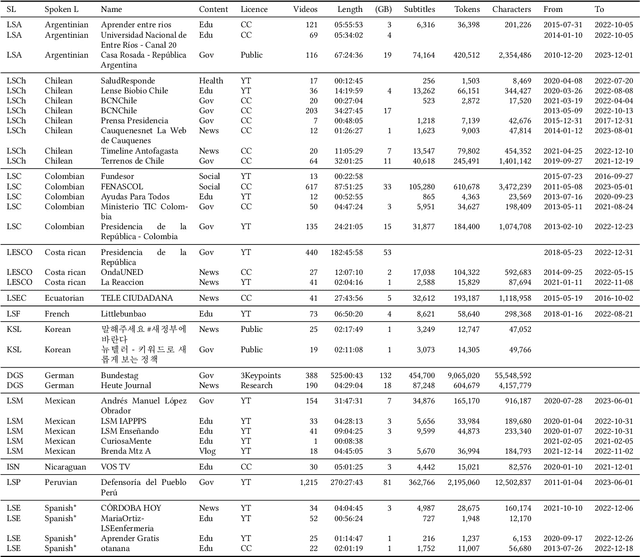
Abstract:We present a collection of parallel corpora of 12 sign languages in video format, together with subtitles in the dominant spoken languages of the corresponding countries. The entire collection includes more than 1,300 hours in 4,381 video files, accompanied by 1,3~M subtitles containing 14~M tokens. Most notably, it includes the first consistent parallel corpora for 8 Latin American sign languages, whereas the size of the German Sign Language corpora is ten times the size of the previously available corpora. The collection was created by collecting and processing videos of multiple sign languages from various online sources, mainly broadcast material of news shows, governmental bodies and educational channels. The preparation involved several stages, including data collection, informing the content creators and seeking usage approvals, scraping, and cropping. The paper provides statistics on the collection and an overview of the methods used to collect the data.
Evaluation of a Sign Language Avatar on Comprehensibility, User Experience \& Acceptability
Aug 07, 2025Abstract:This paper presents an investigation into the impact of adding adjustment features to an existing sign language (SL) avatar on a Microsoft Hololens 2 device. Through a detailed analysis of interactions of expert German Sign Language (DGS) users with both adjustable and non-adjustable avatars in a specific use case, this study identifies the key factors influencing the comprehensibility, the user experience (UX), and the acceptability of such a system. Despite user preference for adjustable settings, no significant improvements in UX or comprehensibility were observed, which remained at low levels, amid missing SL elements (mouthings and facial expressions) and implementation issues (indistinct hand shapes, lack of feedback and menu positioning). Hedonic quality was rated higher than pragmatic quality, indicating that users found the system more emotionally or aesthetically pleasing than functionally useful. Stress levels were higher for the adjustable avatar, reflecting lower performance, greater effort and more frustration. Additionally, concerns were raised about whether the Hololens adjustment gestures are intuitive and easy to familiarise oneself with. While acceptability of the concept of adjustability was generally positive, it was strongly dependent on usability and animation quality. This study highlights that personalisation alone is insufficient, and that SL avatars must be comprehensible by default. Key recommendations include enhancing mouthing and facial animation, improving interaction interfaces, and applying participatory design.
Two Views, One Truth: Spectral and Self-Supervised Features Fusion for Robust Speech Deepfake Detection
Jul 27, 2025Abstract:Recent advances in synthetic speech have made audio deepfakes increasingly realistic, posing significant security risks. Existing detection methods that rely on a single modality, either raw waveform embeddings or spectral based features, are vulnerable to non spoof disturbances and often overfit to known forgery algorithms, resulting in poor generalization to unseen attacks. To address these shortcomings, we investigate hybrid fusion frameworks that integrate self supervised learning (SSL) based representations with handcrafted spectral descriptors (MFCC , LFCC, CQCC). By aligning and combining complementary information across modalities, these fusion approaches capture subtle artifacts that single feature approaches typically overlook. We explore several fusion strategies, including simple concatenation, cross attention, mutual cross attention, and a learnable gating mechanism, to optimally blend SSL features with fine grained spectral cues. We evaluate our approach on four challenging public benchmarks and report generalization performance. All fusion variants consistently outperform an SSL only baseline, with the cross attention strategy achieving the best generalization with a 38% relative reduction in equal error rate (EER). These results confirm that joint modeling of waveform and spectral views produces robust, domain agnostic representations for audio deepfake detection.
One Size Fits None: Rethinking Fairness in Medical AI
Jun 17, 2025Abstract:Machine learning (ML) models are increasingly used to support clinical decision-making. However, real-world medical datasets are often noisy, incomplete, and imbalanced, leading to performance disparities across patient subgroups. These differences raise fairness concerns, particularly when they reinforce existing disadvantages for marginalized groups. In this work, we analyze several medical prediction tasks and demonstrate how model performance varies with patient characteristics. While ML models may demonstrate good overall performance, we argue that subgroup-level evaluation is essential before integrating them into clinical workflows. By conducting a performance analysis at the subgroup level, differences can be clearly identified-allowing, on the one hand, for performance disparities to be considered in clinical practice, and on the other hand, for these insights to inform the responsible development of more effective models. Thereby, our work contributes to a practical discussion around the subgroup-sensitive development and deployment of medical ML models and the interconnectedness of fairness and transparency.
Private kNN-VC: Interpretable Anonymization of Converted Speech
May 23, 2025Abstract:Speaker anonymization seeks to conceal a speaker's identity while preserving the utility of their speech. The achieved privacy is commonly evaluated with a speaker recognition model trained on anonymized speech. Although this represents a strong attack, it is unclear which aspects of speech are exploited to identify the speakers. Our research sets out to unveil these aspects. It starts with kNN-VC, a powerful voice conversion model that performs poorly as an anonymization system, presumably because of prosody leakage. To test this hypothesis, we extend kNN-VC with two interpretable components that anonymize the duration and variation of phones. These components increase privacy significantly, proving that the studied prosodic factors encode speaker identity and are exploited by the privacy attack. Additionally, we show that changes in the target selection algorithm considerably influence the outcome of the privacy attack.
Through a Compressed Lens: Investigating the Impact of Quantization on LLM Explainability and Interpretability
May 20, 2025Abstract:Quantization methods are widely used to accelerate inference and streamline the deployment of large language models (LLMs). While prior research has extensively investigated the degradation of various LLM capabilities due to quantization, its effects on model explainability and interpretability, which are crucial for understanding decision-making processes, remain unexplored. To address this gap, we conduct comprehensive experiments using three common quantization techniques at distinct bit widths, in conjunction with two explainability methods, counterfactual examples and natural language explanations, as well as two interpretability approaches, knowledge memorization analysis and latent multi-hop reasoning analysis. We complement our analysis with a thorough user study, evaluating selected explainability methods. Our findings reveal that, depending on the configuration, quantization can significantly impact model explainability and interpretability. Notably, the direction of this effect is not consistent, as it strongly depends on (1) the quantization method, (2) the explainability or interpretability approach, and (3) the evaluation protocol. In some settings, human evaluation shows that quantization degrades explainability, while in others, it even leads to improvements. Our work serves as a cautionary tale, demonstrating that quantization can unpredictably affect model transparency. This insight has important implications for deploying LLMs in applications where transparency is a critical requirement.
Truth or Twist? Optimal Model Selection for Reliable Label Flipping Evaluation in LLM-based Counterfactuals
May 20, 2025Abstract:Counterfactual examples are widely employed to enhance the performance and robustness of large language models (LLMs) through counterfactual data augmentation (CDA). However, the selection of the judge model used to evaluate label flipping, the primary metric for assessing the validity of generated counterfactuals for CDA, yields inconsistent results. To decipher this, we define four types of relationships between the counterfactual generator and judge models. Through extensive experiments involving two state-of-the-art LLM-based methods, three datasets, five generator models, and 15 judge models, complemented by a user study (n = 90), we demonstrate that judge models with an independent, non-fine-tuned relationship to the generator model provide the most reliable label flipping evaluations. Relationships between the generator and judge models, which are closely aligned with the user study for CDA, result in better model performance and robustness. Nevertheless, we find that the gap between the most effective judge models and the results obtained from the user study remains considerably large. This suggests that a fully automated pipeline for CDA may be inadequate and requires human intervention.
BiCrossMamba-ST: Speech Deepfake Detection with Bidirectional Mamba Spectro-Temporal Cross-Attention
May 20, 2025
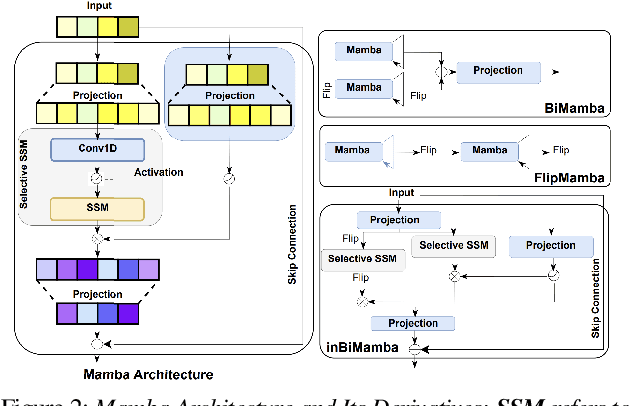
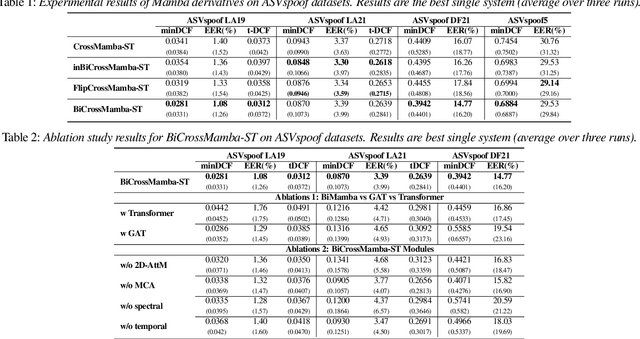

Abstract:We propose BiCrossMamba-ST, a robust framework for speech deepfake detection that leverages a dual-branch spectro-temporal architecture powered by bidirectional Mamba blocks and mutual cross-attention. By processing spectral sub-bands and temporal intervals separately and then integrating their representations, BiCrossMamba-ST effectively captures the subtle cues of synthetic speech. In addition, our proposed framework leverages a convolution-based 2D attention map to focus on specific spectro-temporal regions, enabling robust deepfake detection. Operating directly on raw features, BiCrossMamba-ST achieves significant performance improvements, a 67.74% and 26.3% relative gain over state-of-the-art AASIST on ASVSpoof LA21 and ASVSpoof DF21 benchmarks, respectively, and a 6.80% improvement over RawBMamba on ASVSpoof DF21. Code and models will be made publicly available.
Proceedings of the ISCA/ITG Workshop on Diversity in Large Speech and Language Models
Mar 12, 2025Abstract:Machine learning techniques have conquered many different tasks in speech and natural language processing, such as speech recognition, information extraction, text and speech generation, and human machine interaction using natural language or speech (chatbots). Modern techniques typically rely on large models for representing general knowledge of one or several languages (Large Language Models, LLMs), or for representing speech and general audio characteristics. These models have been trained with large amounts of speech and language data, typically including web content. When humans interact with such technologies, the effectiveness of the interaction will be influenced by how far humans make use of the same type of language the models have been trained on or, in other words, if the models are able to generalize to the language used by humans when interacting with the technology. This may lead to some gradual forms of adaptation in human speech and language production, and users who do not adapt may be excluded from efficient use of such technologies. On top of this, as commercial model development follows market needs, under-represented languages and dialects/sociolects may decrease in terms of priorities. Furthermore, for many lesser spoken languages the necessary data is not available, which will worsen a digital divide in speech and language technology usage. The workshop sets out to discuss this problem based on scientific contributions from the perspective of computer science and linguistics (including computational linguistics and NLP).
 Add to Chrome
Add to Chrome Add to Firefox
Add to Firefox Add to Edge
Add to Edge